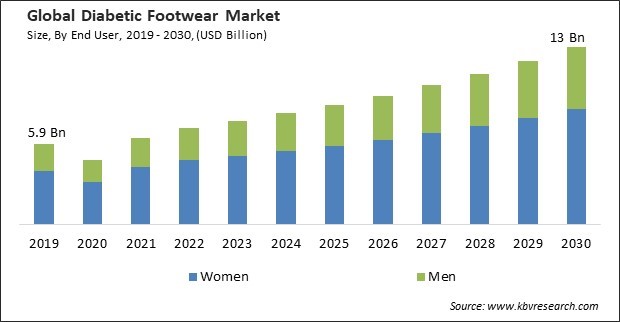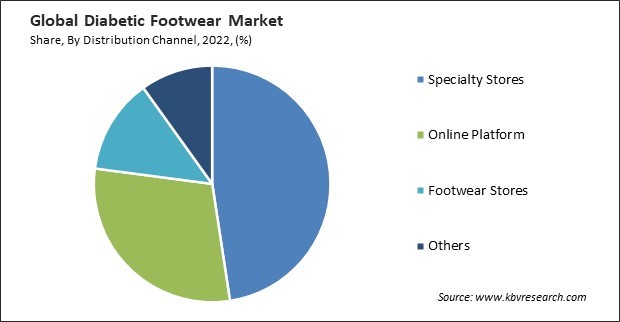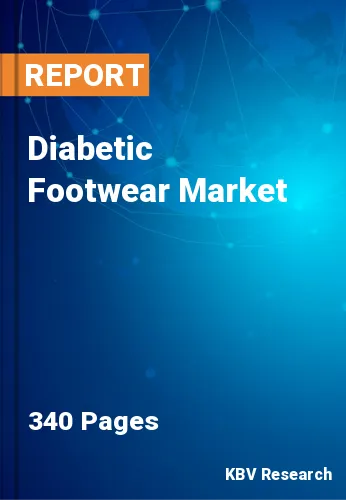The Global Diabetic Footwear Market size is expected to reach $13 billion by 2030, rising at a market growth of 8.0% CAGR during the forecast period. In the year 2022, the market attained a volume of 1,75,471.8 thousand Units experiencing a growth of 8.0% (2019-2022).
Diabetes, both type 1 and type 2, has been on the rise in many European countries. Type 2 diabetes, which is often associated with lifestyle factors, has shown a particularly notable increase. Therefore, Europe segment generated $2,105.7 million revenue in the market in 2022. Europe has been experiencing a rise in diabetes prevalence, attributed to factors such as sedentary lifestyles, unhealthy diets, and an aging population. In order to prevent complications such as foot ulceration, the demand for specialized products such as diabetic footwear increases in tandem with the prevalence of diabetes. As a result, these factors will help in the expansion of the segment. Some of the factors impacting the market are rising number of diabetic patients worldwide, growing aging population in several nations and lack of understanding of the importance of diabetic footwear.

The global increase in the prevalence of diabetes presents a significant public health challenge. With rising urbanization, sedentary lifestyles, and dietary changes, there has been a substantial surge in the number of individuals diagnosed with diabetes worldwide. This increase is particularly noticeable in low- and middle-income countries, where rapid urbanization has led to shifts in dietary patterns and reduced physical activity levels, contributing to the diabetes epidemic. Additionally, the risk of developing diabetes tends to grow with age. Changes in metabolism often accompany aging, reduced physical activity, and an increased likelihood of other health conditions such as obesity and cardiovascular diseases. As a result, a larger proportion of the aging population is diagnosed with diabetes, contributing to the overall rise in diabetes prevalence. Neuropathy can lead to decreased awareness of pain and discomfort, making older adults less likely to notice foot injuries or abnormalities without careful examination. Therefore, these aspects will drive the demand for diabetic footwear in the coming years and these factors will boost the demand in the market.
However, there may be a deficiency in educational initiatives targeting healthcare professionals and individuals with diabetes. A lack of awareness programs and educational campaigns focused on the benefits of diabetic footwear can result in a reduced understanding of its role in preventing foot complications. Healthcare professionals, including general practitioners and even some specialists, may not receive adequate training on diabetic foot care during their education. Limited exposure to the importance of specialized footwear and its role in preventing complications can lead to a lack of proactive patient recommendations. These aspects are expected to limit the growth of the market.
Additionally, the pandemic disrupted global supply chains, affecting the production and distribution of various goods, including diabetic footwear. Lockdowns, social distancing measures, and economic uncertainties influenced consumer behavior. Many retail outlets, including those specializing in medical and orthopedic footwear, faced challenges such as temporary closures, reduced foot traffic, and changes in consumer shopping habits. This affected the sales of diabetic footwear through traditional brick-and-mortar channels. Thus, the COVID-19 pandemic moderately impacted the market.
Based on distribution channel, the market is divided into specialty stores, footwear stores, online platform, and others. The specialty stores segment recorded the maximum revenue share in the market in 2022. Specialty stores often employ knowledgeable staff, including footwear specialists, podiatrists, and diabetes educators. These professionals can provide expert guidance on selecting the most appropriate diabetic footwear based on an individual's specific foot conditions, such as neuropathy or foot deformities. The personalized consultation offered in specialty stores enhances the shopping experience and ensures customers make informed decisions about their footwear. Therefore, there will be increased demand in the segment.

On the basis of end user, the market is bifurcated into men and women. In 2022, the women segment witnessed the maximum revenue share in the market. With an increasing importance on health and wellness, more women are proactively managing chronic conditions like diabetes. This proactive approach extends to foot health, and women are seeking footwear that provides the necessary medical support and aligns with their lifestyle and fashion preferences. Traditional diabetic footwear has often been associated with a clinical and utilitarian appearance. However, the industry is shifting towards more stylish designs. This evolution in fashion trends is particularly appealing to women, who are increasingly looking for diabetic footwear that complements their style. These factors will help in the growth of the segment in future.
Based on type, the market is segmented into shoes, sandals, and slippers. In 2022, the sandals segment garnered a significant revenue share in the market. Sandals are inherently associated with comfort and ease of wear. In the context of diabetic footwear, individuals with diabetes often prioritize comfort due to potential foot sensitivity and neuropathy. Sandals provide an open and breathable design, reducing the risk of friction and pressure points that can lead to foot complications. As a result, there will be increased demand in the segment.
| Report Attribute | Details |
|---|---|
| Market size value in 2022 | USD 7.1 Billion |
| Market size forecast in 2030 | USD 13 Billion |
| Base Year | 2022 |
| Historical Period | 2019 to 2021 |
| Forecast Period | 2023 to 2030 |
| Revenue Growth Rate | CAGR of 8% from 2023 to 2030 |
| Number of Pages | 340 |
| Number of Table | 690 |
| Quantitative Data | Volume in Thousand Units, Revenue in USD Billion, and CAGR from 2019 to 2030 |
| Report coverage | Market Trends, Revenue Estimation and Forecast, Segmentation Analysis, Regional and Country Breakdown, Porter's 5 Forces Analysis, Company Profiling, Companies Strategic Developments, SWOT Analysis, Winning Imperatives |
| Segments covered | Type, Distribution Channel, End User, Region |
| Country scope |
|
| Companies Included | New Balance Athletics, Inc., SKECHERS USA, Inc., Orthofeet, Inc. (Webster Equity Partners), DJO Global (Enovis Corporation), Drew Shoe Corporation, Wolverine World Wide, Inc., Podartis Srl, I-Runner (Healer Health LLC), Pilgrim Shoes and Aetrx Worldwide, Inc. |
| Growth Drivers |
|
| Restraints |
|
By region, the market is segmented into North America, Europe, Asia Pacific, and LAMEA. The North America segment procured the highest revenue share in the market in 2022. North America, particularly the United States and Canada, has a relatively high prevalence of diabetes. The increasing number of individuals diagnosed with diabetes has contributed to a growing demand for specialized diabetic footwear to prevent complications, including foot ulcers. The aging population in North America is more prone to diabetes and related complications. As older people are at a higher risk of developing foot problems, there is an increasing need for diabetic footwear to address this demographic's specific foot care requirements. These aspects will pose lucrative growth prospects for the segment.
Free Valuable Insights: Global Diabetic Footwear Market size to reach USD 13 Billion by 2030
The market research report covers the analysis of key stake holders of the market. Key companies profiled in the report include New Balance Athletics, Inc., SKECHERS USA, Inc., Orthofeet, Inc. (Webster Equity Partners), DJO Global (Enovis Corporation), Drew Shoe Corporation, Wolverine World Wide, Inc., Podartis Srl, I-Runner (Healer Health LLC), Pilgrim Shoes and Aetrx Worldwide, Inc.
By End User (Volume, Thousand Units, USD Billion/Million, 2019-2030)
By Type (Volume, Thousand Units, USD Billion/Million, 2019-2030)
By Distribution Channel (Volume, Thousand Units, USD Billion/Million, 2019-2030)
By Geography (Volume, Thousand Units, USD Billion/Million, 2019-2030)
This Market size is expected to reach $13 billion by 2030.
Rising number of diabetic patients worldwide are driving the Market in coming years, however, Lack of understanding of the importance of diabetic footwear restraints the growth of the Market.
New Balance Athletics, Inc., SKECHERS USA, Inc., Orthofeet, Inc. (Webster Equity Partners), DJO Global (Enovis Corporation), Drew Shoe Corporation, Wolverine World Wide, Inc., Podartis Srl, I-Runner (Healer Health LLC), Pilgrim Shoes and Aetrx Worldwide, Inc.
In the year 2022, the market attained a volume of 1,75,471.8 thousand Units experiencing a growth of 8.0% (2019-2022).
The Shoes segment is generating the highest revenue in the Market by Type in 2022; thereby, achieving a market value of $6.4 Billion by 2030.
The North America region dominated the Market by Region in 2022, and would continue to be a dominant market till 2030; thereby, achieving a market value of $4.9 Billion by 2030.
Our team of dedicated experts can provide you with attractive expansion opportunities for your business.

